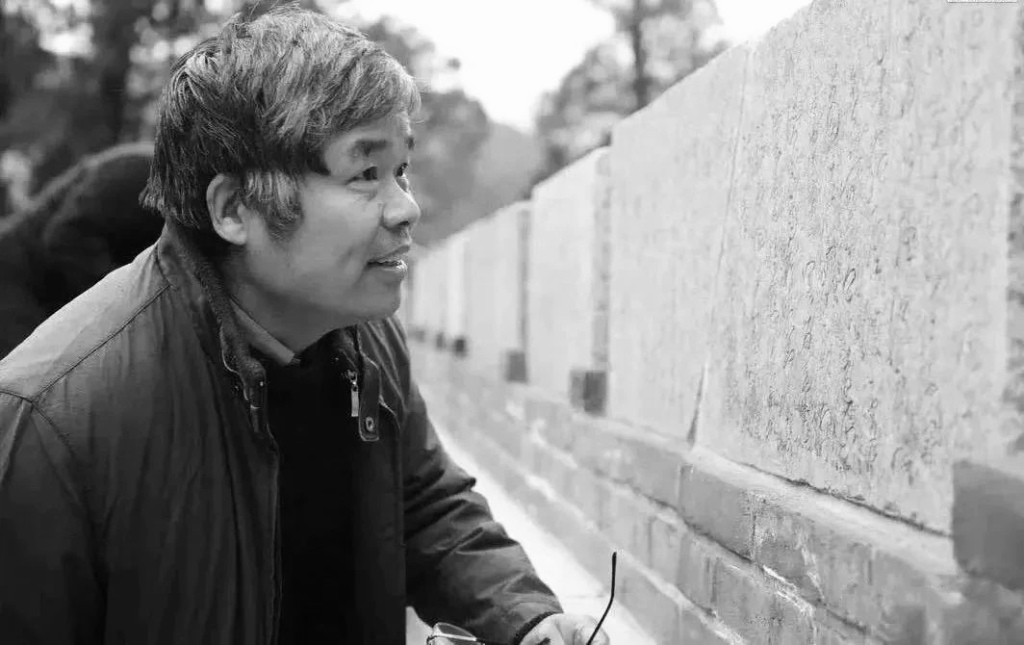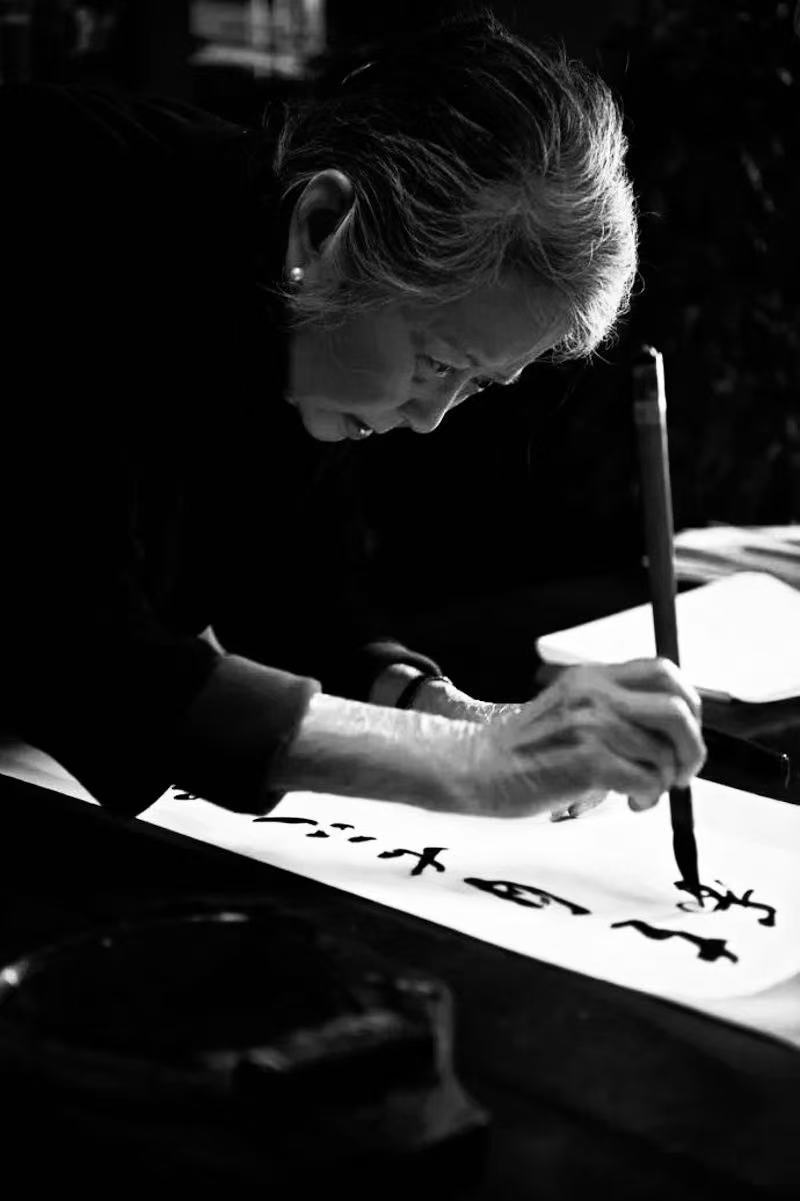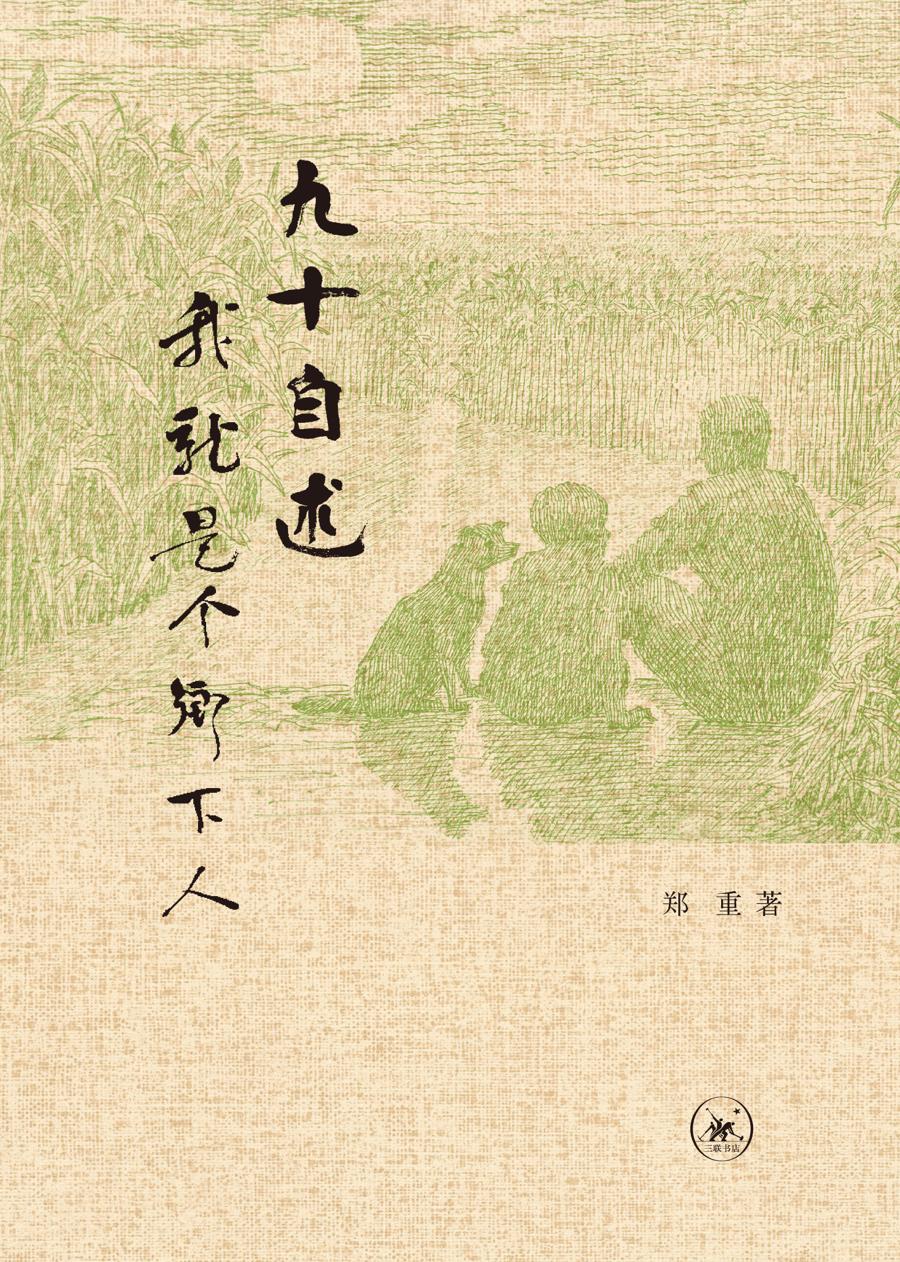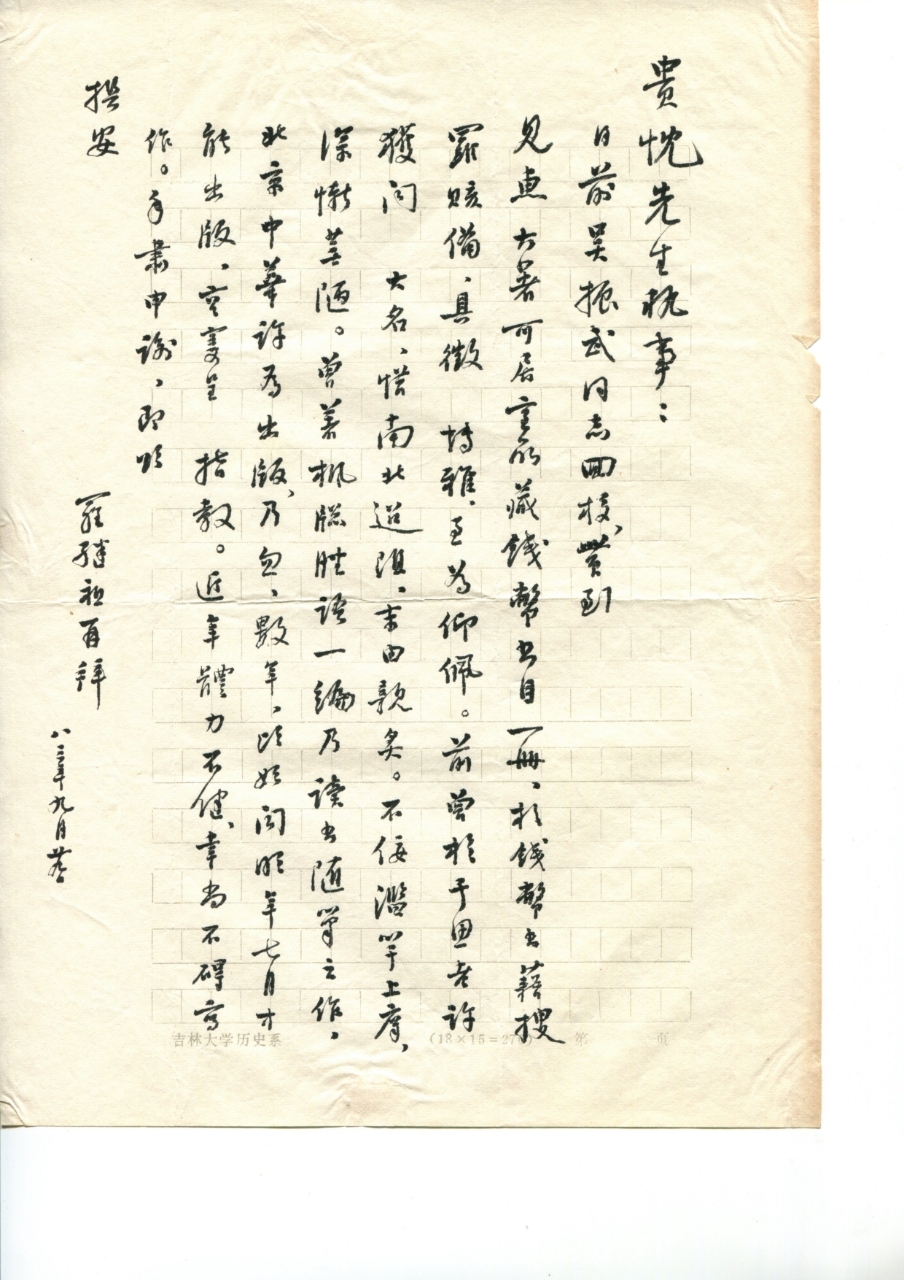
The Paper|Art Review learned that Wo Xinghua, a well-known calligrapher, professor and doctoral supervisor of the Cultural and Museum Department of Fudan University, who had a huge influence on contemporary Chinese calligraphy, died of illness at 8:28 am on July 16, 2025 at the Shanghai Oriental Hospital at the age of 70. Wo Xinghua is a representative figure in the history of contemporary calligraphy who has great pioneering and controversial achievements. His creative practice and theoretical exploration have profoundly influenced the evolution of contemporary Chinese calligraphy in the past three decades. As of 2024, more than 30 monographs have been published, including "Complete Collection of Chinese Calligraphy: Qin and Han Bamboo Slips and Silk Manuscripts" and "General Theory of Calligraphy Techniques".
Mrs. Wo Xinghua, who had just completed the formalities at the hospital, said that according to Wo Xinghua's last wishes, the funeral would be simple and no memorial service would be held.

Wo Xinghua
"Wo Xinghua is very tenacious. He was diagnosed with advanced lung cancer eight years ago, but he has been fighting the disease. Doctors have always praised his tenacity. His condition worsened after he was infected a few months ago and he was transferred to the intensive care unit of Oriental Hospital three months ago. In the past month, he could still express his friends' greetings with facial expressions, sometimes with tears and sometimes with laughter. But his condition has taken a turn for the worse in the past few days." Wo Xinghua's wife told The Paper | Art Review at noon on July 16.

Wo Xinghua calligraphy
Wo Xinghua was born in Shanghai in 1955. He is a well-known calligrapher and professor and doctoral supervisor of the Cultural and Museum Department of Fudan University. He was admitted to the History Department of East China Normal University in 1977. In 1979, he was admitted to the Master's degree in Paleographia and stayed on to teach at the university. He was promoted to professor in 1994 and became a doctoral supervisor in 1995. He has been engaged in teaching and research at East China Normal University and Fudan University for a long time. His research covers the fields of Chinese calligraphy history, Dunhuang calligraphy, and bronze inscription calligraphy. He proposed the "form composition" creation theory, emphasizing the relationship between calligraphy form and spatial modeling. He has hosted the National Exhibition of Calligraphy and Seal Carving by Young and Middle-aged People and the Exhibition of Popular Calligraphy Styles, and has held many personal calligraphy exhibitions at home and abroad. He is not only a scholar, but also a "disruptor" in the calligraphy world - challenging the millennium writing tradition with the theory of "form composition", and reshaping the aesthetic boundaries of contemporary calligraphy amid praise and controversy.
Pan Shanzhu, vice chairman of the Chinese Calligraphers Association and calligrapher, told The Paper: "What a pity! We mourn his passing! His exploration of contemporary calligraphy was of great significance. Calligraphy was his life. He integrated calligraphy creation with academic research. He devoted himself to the exploration and creation of calligraphy, regardless of success or failure. Such a spirit is extremely rare!"
Upon hearing the news of Wo Xinghua's death, Xiao Haichun, a well-known painter in his 80s, choked up and said, "It's very sad. He was my close friend. I heard that he was seriously ill in the first half of the year, and I had a simple phone call with him because he had difficulty speaking. Recalling my interactions with him, he was fully committed to calligraphy research and creation, and was very sincere. I would talk about calligraphy with him every year. I feel very sad when I think about talking to him and the late Le Xinlong. He and Le Xinlong were both rare calligraphers and scholars who could really talk about calligraphy."

Wo Xinghua (left) and Xiao Haichun. October 2022
Zeng Xiang, a calligrapher, curator of the exhibition hall of the China Calligraphy Academy, and master's tutor of the Chinese Academy of Arts, said, "Wo Xinghua is probably the most valuable calligraphy creator of this era. I think other people may write well, but for history, this person (Wo Xinghua) must be remembered in such an era."
"The significance of Teacher Wo Xinghua's exploration of contemporary calligraphy is enormous, and it will surely remain in the history of literati and Chinese calligraphy." Calligrapher and painter Gu Cunyan recalled that he held the "Cunyan Pen and Ink Records" exhibition in Shanghai in 2022, using his brush to record what he heard and saw during the special period of 2022. The name of the exhibition was written by Wo Xinghua: "The loneliness and vigorous momentum in Teacher Wo's calligraphy, I feel it is particularly suitable for such an exhibition. I heard that he was admitted to the ICU ward some time ago, and I was shocked. I made a special trip to visit him a few days ago. At that time, Wo Xinghua could no longer speak, but his mouth was open and his tongue seemed to move. I said at the time: 'Teacher Wo, you must take care of yourself, you are the most powerful, and you will definitely get better!' His mouth was still moving slightly, and I could feel his response. When leaving, I was still saying to him: 'Teacher Wo, come on!' I was thinking about visiting him again in a few days, but I didn't expect him to leave so soon. It's so painful!"

Wo Xinghua's Calligraphy: Village Words and Ink

Oriental Hospital
Wo Xinghua's core theory points directly to the transformation of the essence of calligraphy. He believes that "calligraphy is the division of space by lines" and the first glance should be "the pattern composed of brush and ink and blank space" rather than the text content. The audience first perceives the contrast relationship between thick and thin, sparse and dense, dry and wet, and then recognizes the shape of the characters. He believes that calligraphy faces five major challenges of the times: the creator changes from literati to calligraphers, the function of calligraphy changes from text to image, the communication method changes from a small range to exhibitions, the exhibition space changes from traditional architecture to modern architecture, and computers replace handwriting to make calligraphy completely artistic.
Supporters believe that Wo Xinghua is "the explorer who has gone the furthest and achieved phased results from the perspective of modern aesthetics." Calligraphy theorist Chen Zhenlian commented that he plays the role of "picture on the left and history on the right" in the enlightenment of contemporary aesthetic education - his controversy itself is a catalyst for ideological liberation.
He once said: "Change text into diagram, change reading into watching... I will go even if there are thousands of people against me!"

Wo Xinghua's calligraphy works
Wo Xinghua's exploration has always been based on tradition. In his youth, he practiced the "Duobao Pagoda Stele" and laid a solid and broad tone. He regarded Yan style as "the core of life", and the majestic tension in his running script originated from this. Later, he focused on Mi Fu and Wang Duo. Mi Fu gave him "attitude" (tilted shape), and Wang Duo gave him "spirit" (continuous composition). When he copied, he used the "contrast method": when he lost the feeling of copying, he immediately switched to the opposite style to stimulate innovation.
After Wo Xinghua turned from calligraphy to epigraphy, he proposed the view that "the more refined calligraphy is, the more tasteless it is". By comparing bronze rubbings, he found that severely corroded and broken rubbings have a more "thick and vast" atmosphere of bronze and stone than clear and original rubbings. Therefore, he advocated the acceptance of mottled and blurred brush and ink expressions and opposed excessive modification. This perspective was praised by supporters as "activating the aesthetic legitimacy of Dunhuang manuscripts and tombstone fragments", breaking the binary opposition between calligraphy and epigraphy. He advocated that artists need to be "responsible for the times": after calligraphy has become impractical in the digital age, it must survive through visualization rather than "pleasing the audience". His declaration is straightforward and sonorous: "Change text into diagram, change reading into viewing... history will not remember imitators!"

Wo Xinghua calligraphy
Calligraphy theorist Chen Zhenlian commented on him: "He plays the role of 'image on the left and history on the right' in contemporary aesthetic education enlightenment - his controversy itself is a catalyst for ideological liberation." In his writing, calligraphy is no longer an elegant embellishment, but a wrestling field of space, time and spirit.
If viewed from a century-long perspective, his obsession with the "beauty of relationships" may be paving the way for calligraphy to survive in the digital age.
Wo Xinghua's exploration is like a prism, reflecting the collective anxiety of the modernization of traditional art: He was the first to place calligraphy in the context of global visual culture, challenging the inherent cognition that "writing is calligraphy" and pushing the discipline to face contemporary propositions; his enlightenment lies in: regardless of praise or criticism, the debate he triggered on the nature, boundaries and mission of calligraphy has become an indispensable chapter in the history of contemporary calligraphy.
As he said, "Those who walk alone in the fog, even if they take a wrong step, have broadened the boundaries of the road." The significance of Wo Xinghua may be that he has verified the difficulty and possibility of calligraphy's modern transformation through his own practice.

A few words about calligraphy
/ Wo Xinghua
A person who only knows how to copy ancient works but not how to create cannot be considered a calligrapher, even if his copy is very similar to the original. This is because a calligrapher must be someone who has a critical spirit towards tradition and can put forward his own aesthetic views. Moreover, the more profound the concepts and views, the more difficult it is to come by them, and the less they can be understood by the general public. Therefore, a true calligrapher is often the hardest working and courageous person.
People are born free, but their activities are always restricted by nature and society. This state of human existence is reflected in calligraphy art. In terms of creative spirit, people can be unrestrained and independent, but in terms of creative methods, they must abide by certain rules. This is a pair of contradictions that are difficult to deal with. Most people tend to lean towards two extremes. They either shout for freedom and understand freedom only as getting rid of all the constraints of norms. As a result, once the so-called freedom is obtained, the spirit feels empty, and the works are pale and powerless, empty and slick. Or they take the rules as artistic standards, be cautious and follow the rules, and the works they write are like clay figures and puppets, lifeless. In fact, freedom is a person's command and obedience to himself. It must take values and ideals as the master of action. From the perspective of life, the ultimate goal of human activities is to survive and develop. Therefore, anything that promotes vitality is good and beautiful. Calligraphy creation cannot timidly express traditional norms and repeat personal experience. It should strive to explore and inspire the vitality that has not been sufficient in self-nature, so that the existence of life can be sublimated. Moreover, freedom is also the understanding and utilization of rules. Rules are tools for expressing and communicating thoughts and feelings. Only by looking for rules that suit us from all the experiences of our predecessors and then transforming, utilizing and developing them can we create more wonderful language, express richer thoughts and establish a newer style.
There are words like "ticha", "recognize", "understand", "experience" in Chinese, which all emphasize that we should use our body resources to know and perceive things, and embrace and communicate with the object as a living being. A Zen master said: To know this flower is to become this flower, to bloom like this flower, to enjoy the sunshine and rain. If you do this, the flower will speak to you, let you know all its secrets, all its joys and all its pains, and know all the life pulsating within it.
Calligraphy is an art of symbiosis between time and space. Lines are not only spatial shapes, representing their own forms (horizontal, vertical, left, right, etc.) and character structures, but also a statement of time, representing a continuous flow process. The former is pictorial, while the latter is musical. The pictorial and musical qualities are the charm of calligraphy art. When copying calligraphy, one must break through the limitations of dots and strokes and character shapes, experience their spatial shapes and temporal rhythms, and grasp their pictorial and musical qualities. Generally speaking, spatial shapes are intuitive and easy to grasp, while temporal rhythms are non-intuitive, requiring the copyist to carefully experience them when analyzing the weight, speed, thickness, length, and lifting, pressing, and pauses of the lines. It is said that Wang Xizhi talked about his experience in copying calligraphy and said: "First, correct your hands and feet; second, get the shape; third, slightly resemble the original; fourth, add its vigor and smoothness, and then add pulling and drawing..." That is to say, first get familiar with the hand feeling, then seek the shape of the dots and strokes, make it roughly similar, then express the quality of spatial shapes (vigor and smoothness), and finally write out the temporal rhythm (pulling and drawing). Based on these principles, I think the "similarity in form" of copying corresponds to the spatial characteristics, and the "similarity in spirit" corresponds to the temporal rhythm. The most important thing in copying is to master the temporal rhythm, and the highest level is to restore and reproduce the temporal rhythm.
The tradition of calligraphy art is both objective and subjective; it is both historical and realistic. Therefore, our attitude towards tradition should first be tolerant. Any written remains of our predecessors are objects for us to learn from. Secondly, we should develop, understand and explain tradition from the standpoint of the times, and propose new observation angles and processing methods. But it is very regrettable that people nowadays understand tradition only as famous calligraphy, and inherit tradition only as copying and cloning. The lazy use this to embellish their own lack of thinking, lack of ambition, copying and pasting, and imitating. The powerful use this as a stick to attack creative explorers; and use this as a cover to expand the market and attract business. Radicals shout to break with tradition in order to achieve shocking dramatic effects. Tradition has been completely changed in the contemporary era.

Works by Wo Xinghua

Works by Wo Xinghua
How to innovate calligraphy? Modeling expression and composition relationship. After clarifying that visualization is a development direction, the key to implementing it in creation is to have a solution. There are two ways to enhance the visual effect: focus on modeling expression and focus on composition relationship.
Let's talk about the emphasis on modeling first. The expression of calligraphy art is form and momentum, and their expression effects are completely different.
The expression of momentum is to make the dots and strokes and the structure continuous from top to bottom. In the process of continuity, the rhythm and melody are created through changes such as lifting, pressing, pausing, lightness, heaviness, speed, and separation and discontinuity, which have the characteristics of music. When the viewer faces such a work, no matter where his eyes fall, they will unfold bit by bit along the continuity of the brushstrokes. This kind of appreciation is consistent with the text-style reading. It has a long process and is very attractive and can be savored slowly, but the visual effect is relatively weak.

Wo Xinghua's calligraphy works
Form and momentum each have their own expressive power and should be taken into account. However, "the eyes cannot see clearly in two places", and calligraphy in different historical periods often has different emphases. Today, according to the requirements of visualization, the creative method should re-emphasize the expression of form on the basis of emphasizing momentum.

Wo Xinghua's calligraphy works
Each level can be expressed as a whole or as a part, each has its own expression method and aesthetic content, which should be taken into account. However, because they exclude each other, taking them into account will inevitably lead to bias. Traditional text-based calligraphy naturally chooses the former, emphasizing the unity and perfection of the parts, while contemporary calligraphy should focus on the latter according to the requirements of visualization, emphasizing the compositional relationship in the combination.
Visual creation methods emphasize modeling in the expression of form and momentum, and emphasize the beauty of combination relationship in the beauty of partial perfection and combination relationship. These two methods do not go beyond the expression scope of traditional calligraphy, but only shift the focus of expression. Because of this, many people who are confined to traditional calligraphy suddenly feel uncomfortable and unable to understand, and feel that they "cannot understand".
How to continue tradition through innovation?
Exploring the contrast in calligraphy forms has become a history of calligraphy
Any innovation is based on tradition. Therefore, to talk about innovation, we must first clarify what is tradition and what is the form of expression of traditional calligraphy. If this issue is not clarified, innovation will be blind and at a loss, and because it cannot be linked to previous developments, it will have no historical value.
The art of calligraphy originates from nature and expresses nature. In traditional concepts, “nature” includes not only everything in the universe, but also people and their emotions. Therefore, the ancients defined calligraphy as “writing is the law of images” and “writing is the painting of the heart”.
How can such nature be expressed? Yin and Yang. “One Yin and one Yang is the Tao.” In traditional culture, Yin and Yang are highly abstract symbols that can express the existence and relationship of all things.

Wo Xinghua's calligraphy works
Heaven is yang, earth is yin; man is yang, woman is yin; movement is yang, stillness is yin...Specifically in the art of calligraphy, it is all kinds of opposite and complementary contrast relationships. In the use of the brush, it is light and heavy, fast and slow; in the strokes, it is thick and thin, square and round; in the structure, it is big and small, straight and side; in the composition, it is sparse and dense, empty and solid; in the ink color, it is thick and light, dry and wet...No matter whether it is "image by law" or "painting by heart" in the art of calligraphy, all expressions are completed through various contrast relationships. Therefore, Cai Yong said, "Once nature is established, yin and yang are born."
However, there are many such contrasting relationships, and they are constantly evolving with the development of calligraphy art. The history of “ancient simplicity and modern beauty” is actually the history of the development of contrasting relationships.

Wo Xinghua's calligraphy works
There are more and more contrasting relationships in calligraphy art. If they are combined, they can be divided into two categories: one is shape, such as thickness, squareness, size, front and side, etc., which is the state and position of space; the other is momentum, such as lightness, speed, separation, discontinuity, etc., which is the movement and rhythm of time. Shape and momentum are the summary of various contrasting relationships. Therefore, Cai Yong also said that "when yin and yang are born, the situation emerges." In the final analysis, the expression of calligraphy art is shape and momentum.
Cai Yong's first sentence is straight to the point: "Writing originates from nature. Once nature is established, yin and yang are born; once yin and yang are born, shape and form emerge." This sentence is concise and explains the content and form of calligraphy art. As a classic, it has a far-reaching influence. The subsequent development of calligraphy art revolves around this theory. Therefore, today's innovative calligraphy expressions are traditional as long as they are still within the scope of shape and form.
The same is true for the two creative methods mentioned above. Whether emphasizing the modeling expression based on brushstrokes or emphasizing the combination relationship through formal composition, when it comes to specific creation, they all rely on various contrast relationships such as lightness and heaviness, speed, thickness and thinness, squareness and roundness, size, front and side, density, virtuality and reality, dryness and wetness, and thickness and thinness. They are all within the scope of shape and momentum, and are therefore traditional.
There is no fundamental difference between the forms of expression of innovative calligraphy and traditional calligraphy, so where is its innovation reflected? It is reflected in the degree of expression.

Mr. Wo Xinghua
Today, calligraphers are not literati in the traditional sense, and their calligraphy works are not their own poems or essays. They pay special attention to visual effects when creating. Calligraphy appreciation is not mainly about reading but watching, which is an aesthetic pleasure.
The creation and appreciation of contemporary calligraphy have gradually changed from "reading" texts to "looking" at diagrams. The requirements for text interpretation are weakening, while visual requirements are increasing. This has liberated the expression of various contrast relationships and changes in situations to a great extent. Although calligraphy art is still writing, it can be more bizarre in shape, more unrestrained in rhythm, and everything can be expressed more exaggeratedly and intensely.


